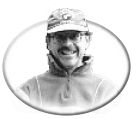
Trolling for Salmon
Part Three
Hot Lures and How to Rig Them
with
D.C. Reid
illustrations by Barb Krimmer
The novice fisher believes that you go out at 2:00 in the afternoon, plunk the crusty, unnameable lure from aunt Betsy’s dusty old attic into the water and voila, the salmon be on the line. Nothing, unfortunately, could be further from the truth. Fishing for salmon, particularly trolling for salmon, is more specific than first meets the eye.
Salmon lures come in a bewildering variety. One line of plug, for instance, has 700 different colour combinations; one line of hootchie, several hundred. On any given day, in any given location perhaps one of these colours will do the trick. All the other combinations, all the other sizes and all the other lures on the market will catch nothing. There are also spoons, baitheads, apex style lures, lures that spiral as they troll, etc. All, again, come in different sizes and colour combinations.
It is no accident that 80% of the fish are brought home by 20% of the fishers. These people have invested the time - and money - to make sure that they have the exact right thing at the moment of need. I have three tackle boxes of gear and buy two of every lure purchased. The reason is simple. If only one lure out of the thousands of possibilities will do the trick, then I want two of them in case I lose one. Furthermore, I want to put the second lure on the line so that at least two of my rods have some possibility of receiving strikes.
Lure selections should be made in conjunction with tackle shops or marinas; they have current knowledge. Lure rigging may be gleaned from the following diagrams. Please note that the rigging schemes suggested here may require minor modifications in each fishing area.
More salmon are caught on bait in more locations in British Columbia than any other lure. Note that ball-bearing swivels are essential to eliminate the line twist that results from the natural action of trolled bait: a spiral of 1 to 6 inches diameter. Most commonly, bait combines with a dodger, a chromed metal strip that sways back and forth. The two most common rigs are:

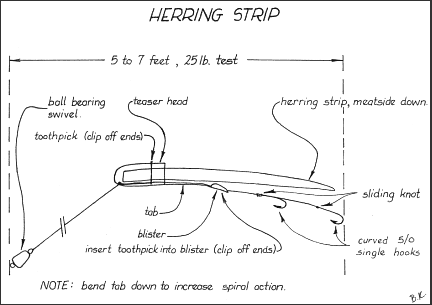
The second most commonly used lure, the hootchie, resembles a squid. These are sold in three sizes: plankton, squirt and hootchie. The most important point to remember is that leader should be 25- to 40-pound test. All hootchies should be fished with a flasher, a plastic strip that emits a flash of light each time it revolves.
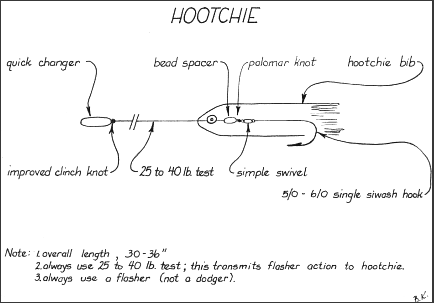
Clean in design, plugs are my lure of choice for trolling. They are simple lures to fish, and hook fish solidly.

Spoons lay claim to being the salmon lure of greatest tradition, the old copper commercial lures having trolled millions of fish from the seas over the decades. Make sure to take the Krippled K and insert a slight, crooked bend in the tail third of the lure. The assymetry is what kills the fish.
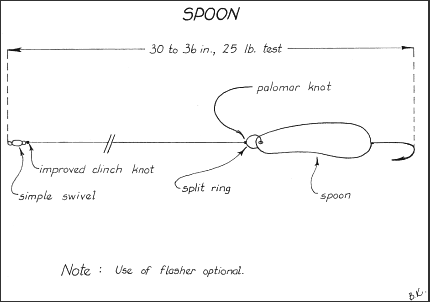
Hard as it may be to be believed, bucktail flies made out of polar bear hair actually catch more salmon than other flies. Perhaps it is the wavy fur or the fact that the individual hairs are hollow, a feature that provides polar bears fine insulation from northern cold. Too bad the lures cost three times as much as other varieties. Buy them anyway; the objective is catching fish
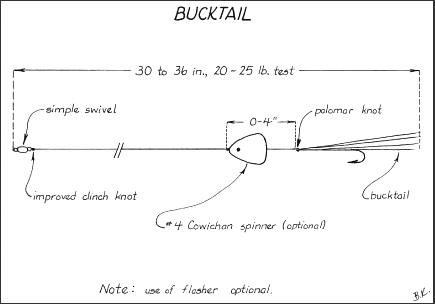
These rig designs have evolved over the decades and are very specific. You will catch more fish if you observe and dutifully incorporate each and every detail. Having said this, it has to be admitted once again that local variations will outproduce these basics and, therefore, must be included in your own versions of them. The most obvious variant is leader length. Each area - and these can be as close as ten miles from one another - has a specific length for each specific species, and sometimes within the same species. Sometimes, for example, coho runs as little as two weeks apart require different leader lengths!
I have not said anything about specific colours; they are a local consideration. Generally speaking, however, baitheads should be of the glow varieties or the new painted versions that reproduce hootchie colours; hootchies - most lures for that matter - should be ultraviolet as well as glow in the dark; remember to use red spoons in fall, green in winter; generally use white or light first thing in the morning, and then move to darker colours as light comes on the water.
And don’t be shy. Carry binoculars for finding out what the guy next to you is doing when he has a fish at the side of the boat. Immediately change to that lure. If you have been following the instructions here, you will find two of the necessary lure in your tackle box because you were in the marina early this morning with a wheelbarrow full of money. Now content yourself to use the wheelbarrow to cart the fish you caught back up the dock. Best of luck.
|









